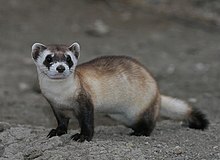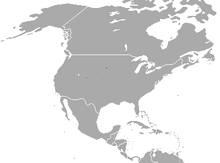Black-footed ferret
| Black-footed ferret | |
|---|---|
 |
|
| Scientific classification | |
| Kingdom: | Animalia |
| Phylum: | Chordata |
| Class: | Mammalia |
| Order: | Carnivora |
| Suborder: | Caniformia |
| Family: | Mustelidae |
| Genus: | Mustela |
| Species: | M. nigripes |
| Binomial name | |
|
Mustela nigripes (Audubon & Bachman, 1851) |
|
 |
|
| Black-footed ferret range (three small areas on USA territory) | |
The black-footed ferret (Mustela nigripes), also known as the American polecat or prairie dog hunter, is a species of mustelid native to central North America. It is listed as endangered by the IUCN, because of its very small and restricted populations. First discovered by Audubon and Bachman in 1851, the species declined throughout the 20th century, primarily as a result of decreases in prairie dog populations and sylvatic plague. It was declared extinct in 1979 until Lucille Hogg's dog brought a dead black-footed ferret to her door in Meeteetse, Wyoming in 1981. That remnant population of a few dozen ferrets lasted there until the animals were considered extinct in the wild in 1987. However, a captive breeding program launched by the United States Fish and Wildlife Service resulted in its reintroduction into eight western states and Mexico from 1991 to 2008. There are now over 1,000 mature, wild-born individuals in the wild across 18 populations, with four self-sustaining populations in South Dakota (two), Arizona and Wyoming.
The black-footed ferret is roughly the size of a mink, and differs from the European polecat by the greater contrast between its dark limbs and pale body and the shorter length of its black tail-tip. In contrast, differences between the black-footed ferret and the steppe polecat of Asia are slight, to the point where the two species were once thought to be conspecific. The only noticeable differences between the black-footed ferret and the steppe polecat are the former's much shorter and coarser fur, larger ears, and longer postmolar extension of the palate.
...
Wikipedia

